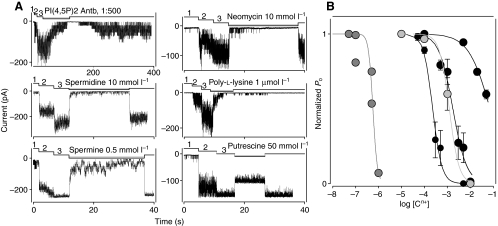Fig. 2.
Application of organic polyvalent cations (Cn+) and an anti-PI(4,5)P2 antibody blocks the lobster SGC channel in cell-free, inside-out membrane patches. (A) Current traces of channels blocked by Cn+ and an anti-PI(4,5)P2 antibody. Channels were first activated by Na+ (210 mmol l−1) and Ca2+ (100 μmol l−1). Gray lines mark the time courses of an anti-PI(4,5)P2 antibody and Cn+ application. Note, Cn+ reduced the open probability of the channel rather than decreasing the single channel amplitude. The discrete current levels seen on the traces reflect current through different numbers of simultaneously open channels. Note: the PI(4,5)P2 antibody acted considerably slower than the Cn+. Holding potential, −70 mV. Electrode solution: NaCl (210 mmol l−1) + Ca2+ (10 nmol l−1). 1, LiCl (210 mmol l−1) + Ca2+ (10 nmol l−1); 2, NaCl (210 mmol l−1) + Ca2+ (10 nmol l−1); 3, NaCl (210 mmol l−1) + Ca2+ (100 μmol l−1). (B) Plot of the concentration dependence of the effect of Cn+ (in mol l−1) on the SGC channel. Each point is the mean ± s.e.m. of the normalized current from 3–7 patches. Solid lines: Hill plots with the following parameters according to potency: [poly-l-lysine]1/2=0.57 μmol l−1, h=4.5, n=2–6; [spermine]1/2=229 μmol l−1, h=2.2, n=3–7; [neomycin]1/2=1.2 mmol l−1, h=2, n=3–6; [spermidine]1/2 =1.74 −1 mmol l, h=1.4, n=3–6; [putrescine]1/2=73 mmol l−1, h=0.9, n=3–6.

